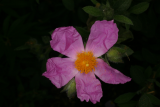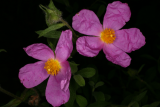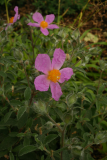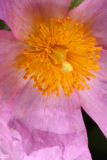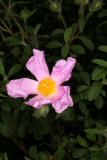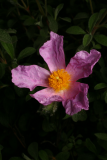Additional notes (click to expand)
Medicinal
Source of a resin, similar to ladanum from Cistus ladanifer, which may be the Myrrh of Genesis. The resin, used medicinally in former times, from both these plants is obtained by boiling twig when resin can be skimmed from the water surface.
Mabberley, DJ. (1987). The Plant Book, Cambridge University Press
‘Ladanum dronketh with olde wine, stoppeth the laske [periods], and provoketh urine. It is very good against the hardness of the matrix or mother [uterus] layde to in the manner of a pessarie, and it draweth down the secondes or afterbirth, when it is layde upon quicke coles [hot coals], and the fumigation or parfume thereof be received up into the body of women. // The same applied to the head with Myrrhe and oyle of Myrrhe, cureth the scurffe, called Alopecia, and keepeth the heare [hair] from falling"
Dodoens, Rembert. (1554). Cruydtboeck. Leduven.
Other use
Cistus incanus ssp creticus Juss. Cistaceae. Rock Rose. Distribution: Crete. Interesting symbiosis with fungus called Tuber melanosporum which increases nutrient absorption for the plant and inhibits growth of other plants in the vicinity. It is a source of the resin ‘labdanum’ (a.k.a. ‘ladanum’) used in perfumes (similar smell to ambergris), as is Cistus ladanifer. It has no medical uses now, and such use was dwindling even in the 18th century. In the 16th century (Henry Lyte’s 1575 translation of Rembert Dodoen’s Cruydeboeck of 1554) its uses were described (directly copied from Dioscorides’ Materia Medica (70AD)) as: ‘Ladanum dronketh with olde wine, stoppeth the laske [periods], and provoketh urine. It is very good against the hardness of the matrix or mother [uterus] layde to in the manner of a pessarie, and it draweth down the secondes or afterbirth, when it is layde upon quicke coles [hot coals], and the fumigation or parfume thereof be received up into the body of women. // The same applied to the head with Myrrhe and oyle of Myrrhe, cureth the scurffe, called Alopecia, and keepeth the heare [hair] from falling of [sic], but whereas it is already fallen away, it will not cause the heare to growe agayne. // ...' and goes on in this vein about its uses for pain in the ears, and removing sores and scars and other things.
Oakeley, Dr. Henry F. (2013). Wellcome Library notes.
link
Cistus creticus subsp. incanus (L.) Heywood
Family: CISTACEAEGenus: Cistus
Species: creticus
SubSpecies: incanus (L.) Heywood
Common names: Cretan rockrose
Distribution summary: Mediterranean
Habit: Shrub
Hardiness: H3 - Half hardy; unheated greenhouse/mild winter
Habitat: Rocky slopes, scrub & light woodland
Garden status: Currently grown
Garden location: Plants of the World (B), Plants of the World (D), Classical Europe & Middle East (M)
Flowering months: June
Reason for growing: Other use
